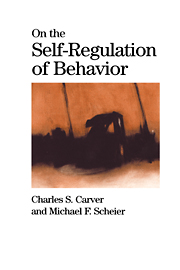Book contents
- Frontmatter
- Contents
- Preface
- Acknowledgments
- 1 Introduction and Plan
- 2 Principles of Feedback Control
- 3 Discrepancy-Reducing Feedback Processes in Behavior
- 4 Discrepancy-Enlarging Loops, and Three Further Issues
- 5 Goals and Behavior
- 6 Goals, Hierarchicality, and Behavior: Further Issues
- 7 Public and Private Aspects of the Self
- 8 Control Processes and Affect
- 9 Affect: Issues and Comparisons
- 10 Expectancies and Disengagement
- 11 Disengagement: Issues and Comparisons
- 12 Applications to Problems in Living
- 13 Hierarchicality and Problems in Living
- 14 Chaos and Dynamic Systems
- 15 Catastrophe Theory
- 16 Further Applications to Problems in Living
- 17 Is Behavior Controlled or Does It Emerge?
- 18 Goal Engagement, Life, and Death
- References
- Name Index
- Subject Index
5 - Goals and Behavior
Published online by Cambridge University Press: 05 June 2012
- Frontmatter
- Contents
- Preface
- Acknowledgments
- 1 Introduction and Plan
- 2 Principles of Feedback Control
- 3 Discrepancy-Reducing Feedback Processes in Behavior
- 4 Discrepancy-Enlarging Loops, and Three Further Issues
- 5 Goals and Behavior
- 6 Goals, Hierarchicality, and Behavior: Further Issues
- 7 Public and Private Aspects of the Self
- 8 Control Processes and Affect
- 9 Affect: Issues and Comparisons
- 10 Expectancies and Disengagement
- 11 Disengagement: Issues and Comparisons
- 12 Applications to Problems in Living
- 13 Hierarchicality and Problems in Living
- 14 Chaos and Dynamic Systems
- 15 Catastrophe Theory
- 16 Further Applications to Problems in Living
- 17 Is Behavior Controlled or Does It Emerge?
- 18 Goal Engagement, Life, and Death
- References
- Name Index
- Subject Index
Summary
You must imagine your life … and then it happens.
(John Updike, The Witches of Eastwick)To say that behavior is regulated by feedback processes is to assume the existence of reference values for behavior. In this chapter we consider reference values and some differences among them. For most practical purposes the term reference value is interchangeable with the term goal. Life, in this framework, is a continual process of establishing goals and adjusting patterns of behavior to match those goals more closely, using informational feedback as a guide.
GOALS
This emphasis on goals is very much in line with a growing emphasis on goal constructs in today's personality–social psychology (Austin & Vancouver, 1996; Elliott & Dweck, 1988; Miller & Read, 1987; Pervin, 1982, 1989). A variety of labels are used in this literature, reflecting differences in the emphases that various writers place on aspects of the goal construct. The next section briefly reviews a few of these constructs.
An Overview of Broad Goal Constructs
One of the earliest of this generation of goal constructs was Klinger's (1975, 1977) use of the phrase current concern to describe goals with which a person is presently engaged. This phrase conveys the sense that the goals are temporary. They occupy the mind for a while but eventually yield to other concerns. The phrase also suggests a sense of mental engagement with an issue or problem, a quality of unfinished business.
Information
- Type
- Chapter
- Information
- On the Self-Regulation of Behavior , pp. 63 - 82Publisher: Cambridge University PressPrint publication year: 1998
Accessibility standard: Unknown
Why this information is here
This section outlines the accessibility features of this content - including support for screen readers, full keyboard navigation and high-contrast display options. This may not be relevant for you.Accessibility Information
- 4
- Cited by
